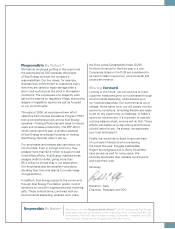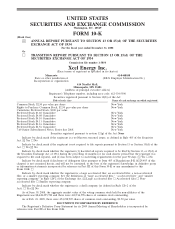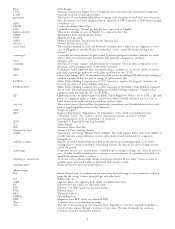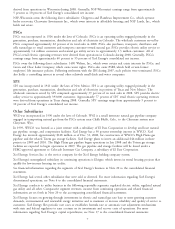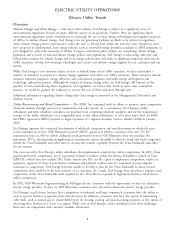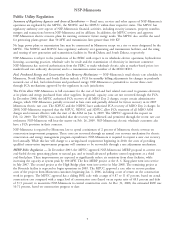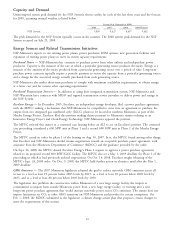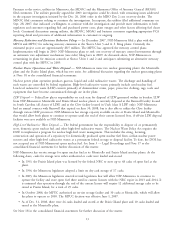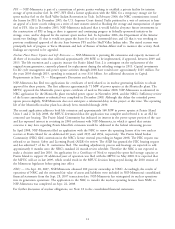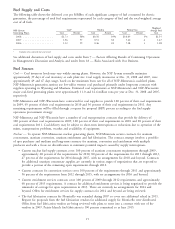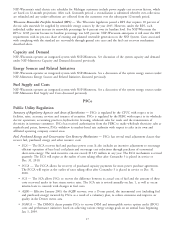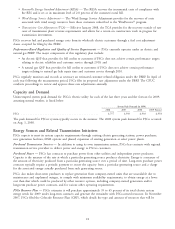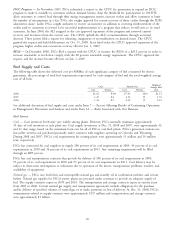Xcel Energy 2008 Annual Report Download - page 20
Download and view the complete annual report
Please find page 20 of the 2008 Xcel Energy annual report below. You can navigate through the pages in the report by either clicking on the pages listed below, or by using the keyword search tool below to find specific information within the annual report.
Capacity and Demand
Uninterrupted system peak demand for the NSP System’s electric utility for each of the last three years and the forecast
for 2009, assuming normal weather, is listed below.
System Peak Demand (in MW)
2006 2007 2008 2009 Forecast
NSP System .......................... 9,859 9,427 8,697 9,662
The peak demand for the NSP System typically occurs in the summer. The 2008 system peak demand for the NSP
System occurred on July 29, 2008.
Energy Sources and Related Transmission Initiatives
NSP-Minnesota expects to use existing power plants, power purchases, DSM options, new generation facilities and
expansion of existing power plants to meet its system capacity requirements.
Purchased Power — NSP-Minnesota has contracts to purchase power from other utilities and independent power
producers. Capacity is the measure of the rate at which a particular generating source produces electricity. Energy is a
measure of the amount of electricity produced from a particular generating source over a period of time. Long-term
purchase power contracts typically require a periodic payment to secure the capacity from a particular generating source
and a charge for the associated energy actually purchased from such generating source.
NSP-Minnesota also makes short-term purchases to comply with minimum availability requirements, to obtain energy
at a lower cost and for various other operating requirements.
Purchased Transmission Services — In addition to using their integrated transmission system, NSP-Minnesota and
NSP-Wisconsin have contracts with MISO and regional transmission service providers to deliver power and energy to
the NSP System.
Excelsior Energy — In December 2005, Excelsior, an independent energy developer, filed a power purchase agreement
with the MPUC seeking a declaration that NSP-Minnesota be compelled to enter into an agreement to purchase the
output from two integrated gas combined cycle (IGCC) plants to be located in northern Minnesota as part of the
Mesaba Energy Project. Excelsior filed this petition making claims pursuant to Minnesota statutes relating to an
Innovative Energy Project and Clean Energy Technology. NSP-Minnesota opposed the petition.
The MPUC referred this matter to a contested case hearing before an ALJ to act on Excelsior’s petition. The contested
case proceeding considered a 600 MW unit in Phase 1 and a second 600 MW unit in Phase 2 of the Mesaba Energy
Project.
The MPUC issued its order for phase 1 of the hearing on Aug. 30, 2007. In it, the MPUC found among other things,
that Excelsior and NSP-Minnesota should resume negotiations toward an acceptable purchase power agreement, with
assistance from the Minnesota Department of Commerce (MDOC) and the guidance provided by the order.
On Sept. 24, 2008, the MPUC denied Excelsior Energy’s Phase 2 request to approve a power purchase agreement
related to its proposed second 600 MW IGCC facility. The MPUC also set a May 1, 2009 deadline for Phase 1 of the
proceeding in which it had previously ordered negotiations. On Oct. 14, 2008, Excelsior sought rehearing of the
MPUC’s Sept. 24, 2008 order. On Dec. 9, 2008, the MPUC held further action in abeyance until after the May 1,
2009 deadline.
GHG Emissions — The 2007 Minnesota legislature adopted the goal to reduce statewide GHG emissions across all
sectors to a level at least 15 percent below 2005 levels by 2015, to a level at least 30 percent below 2005 levels by
2025, and to a level at least 80 percent below 2005 levels by 2050.
The legislation also prohibits the construction within Minnesota of a new large energy facility, the import or
commitment to import from outside Minnesota power from a new large energy facility, or entering into a new
long-term power purchase agreement that would increase statewide power sector CO2 emissions. The statute does not
impose limitations on CO2 or other GHG emissions on NSP-Minnesota and provides for certain exemptions. On
Feb. 1, 2008, the MDOC submitted to the legislature a climate change action plan that proposes certain changes to
meet the requirements of this section.
10


